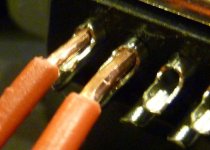The Mighty Volt
1 MW
johnrobholmes said:Lead free is indeed a pain to use. It just doesn't wet and flow well.
Yeah, I was noticing this. I got 2 rolls of really cheap lead junk solder off Ebay and the stuff was magic.
This stuff needs a daub of the flux from my little tin to work. It was also bloody expensive. I thought I was getting something special.
Back to the old reliable again: eBay. This is what I have my eye on: http://cgi.ebay.co.uk/ws/eBayISAPI.dll?ViewItem&item=250688023350&ssPageName=STRK:MEWAX:IT and http://cgi.ebay.co.uk/Kester-Solder-Wire-63-37-0-5mm-245flux-No-Clean-core-50-/170520353767?pt=LH_DefaultDomain_3&hash=item27b3ce1be7
Thanks again.




